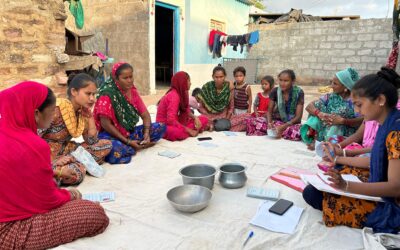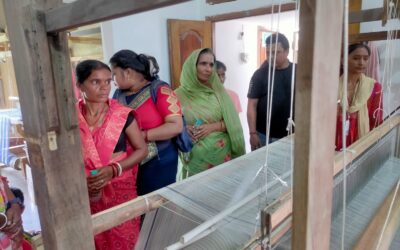Laborers at the Surat Sabji Mandi. Image courtesy IndiaMart
AMBOLI NAKA
Amboli is located in the Kamrej taluka of Surat district, Gujarat. Situated on the outskirts of the Surat city, it is a growing hub of industries. In the last ten years there has been a substantial rise in the number of industries along with housing construction in this area. Being an area of urbanisation, Amboli is a hot spot for different levels of construction sector activities. A large number of migrant workers from the neighboring states of Rajasthan and Madhya Pradesh work in these construction units. Majority of the workers are from Banswara of South Rajasthan and Ratlam of Madhya Pradesh. A good proportion of workers is also from Dahod of Gujarat. The migrant workers live in open spaces near Meladi Mandir on the banks of Tapi river. It is approximately 7-8 km from the naka.

Amboli is one of the oldest nakas (almost 30 years old) in Surat for migrant construction workers. The migrants prefer this naka over other areas as there is a high demand of laborers. An estimated 2500 workers (male – 65%; female – 35%) can be found in the naka on any given day. The workers can be classified into three categories on the basis of their commitment of labor:
- Uchhak labourers – A group of labourers who work on contracts. They decide a deadline for their work and usually work accordingly to meet the deadline. 50-60% of the total number of migrants available in the naka on any given day is of this category.
- Couple labourers – A husband and wife form a group and work on the sites on a daily basis or in a contract. 35-40% of the laborers found in the naka on any given day is of this category.
- Individual labourers – A single male laborer who works independently according to the requirement of hiring. The work can be of one day or on the basis of a contract. 3-5% of this kind of workers can be found on any given day in naka.


The peak time to find workers in the naka is between 7 to 8 am. A worker from Amboli naka usually works from 9 am to 6 pm. About 30% of the workers in the naka do not get work everyday. In a month, a worker usually gets work for 20-22 days. Main problems faced by the workers include – multiple cases of eve teasing and frequent thefts. The specialty of the naka includes,
- Food stalls set up under the Annapurna Scheme by the Central Government provides food as cheap as Rs. 10
- Dhanwantari Arogya Rath scheme by the Gujarat government (BOCW) provides free on-site health check-up for construction laborers
- Daily wages are comparatively higher than the other nakas
- Women karigars can be found
- Demand for work is higher than other nakas
~~~
LALITA CHOKDI NAKA
Lalita chowkdi is located in the Surat City East Assembly Constituency, Gujarat. It is situated in the city. Earlier the naka used to be near Pipal Ashram from mid 1990s to 2005. It shifted to its current location around 2005 and is getting densely populated every year. A lot of power loom units inside Surat have been shut down in the last five years. Most of them have shifted to Sayan and Anjani region which is 8-10 km on the outskirts of the city. Migrant construction workers can be found in this ‘chowkdi’ who are hired for different construction sector work either in the city or in the outskirts of the city. Rise in construction business in these areas in last few years have made Lalita chowkdi one of the most popular nakas. Migrant workers here are mostly from Sajjangarh (Banswara) of Rajasthan, Ratlam of Madhya Pradesh and few from Zalod (Dahod) in Gujarat. The workers stay in open spaces 0-10 km away from the naka in Lalita Chowkdi, Ambatalavadi, Hati Mandir, Dabholi and Singanapur.

A majority of new migrants in the city of Surat who come to work in the construction sector choose Lalita Chowkdi as it is growing everyday. Almost 3000-3500 (male – 65%; female – 35%) workers can be found in the naka on any given day.


The peak time to find workers in the naka is between 7 to 8 am. A worker from Lalita Chowk naka usually works from 9 am to 6 pm. About 60-70% of the workers in the naka do not get work everyday. In a month, a worker usually gets work for 20-22 days. Major issues include – payment of wage related disputes, multiple cases of eve-teasing reported, traffic police does not allow migrants to form crowd in the naka. Prayas, a local non profit in the region issues membership cards and conducts occasional meeting with women laborers for their welfare. The naka’s specialty includes:
- Food stalls set up under the Annapurna Scheme by the Central Government provides food as cheap as Rs. 10
- Dhanwantari Arogya Rath scheme by the Gujarat government (BOCW) provides free on-site health check-up for construction laborers
- Pay and use toilet is available
- Located in the middle of the city (accessible for all urban benefits from this place)
~~~
YOGI CHOWK NAKA
Yogi chowk is located in the Kamrej Assembly Constituency, Surat in Gujarat. This place marks the borders of the Surat Municipal Corporation (SMC). This naka is formed of two distinct nakas very close to each other which makes it unique. Simada is one of the nakas which mostly has workers from Ratlam of Madhya Pradesh and few from Zalod (Dahod) of Gujarat. The other naka is Savalia circle which mostly has migrant workers from Sajjangarh (Banswara) of Rajasthan, and Petlad town in Gujarat. Kathiyawari community form the majority of the population in this area. The construction sector boom just outside the jurisdiction of SMC makes this place a perfect naka. The workers stay in open spaces 10-15 km away from the naka around BRTS road, Vanmari junction, Shyamdhan Mandir, Meladi Mandir and Canal Road.

The number of migrant workers in this naka is comparatively less than the other nakas. Almost 2200-2500 (male – 65%; female – 35%) workers can be found in the naka on any given day.


The peak time to find workers in the naka is between 7 to 8.30 am. A worker from Yogi chowk naka usually works from 9 am to 6.30 pm. About 60-70% of the workers in the naka do not get work everyday. In a month, a worker usually gets work for 20-22 days. Problems faced by the workers majorly include – payment of wage related disputes and non co-operating local people who does not support over-crowding and chaos caused by the workers. Prayas is operational here as well. Naka specialty includes:
- Two separate nakas – Simada and Savalia collectively form the Yogi Chowk naka
- UHC is very close
- Food stalls set up under the Annapurna Scheme by the Central Government provides food as cheap as Rs. 10
- BRTS bus service




Engaging read
Thank You 🙂
Thank You 🙂
Such an information packed post. Fellows at Aajeevika have changed the way I look at Nakas now. This helps build the perspective even more.